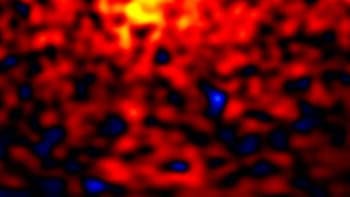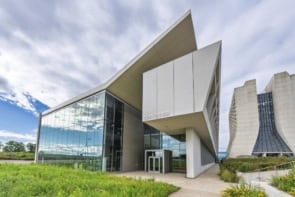The deep underground laboratories of the world are no longer the scientific realm of astroparticle physics alone. From Mars rovers to muon tomography, and from radioactive dating to astrobiology, Sean Paling and Stephen Sadler describe the renaissance in the science taking place far beneath our feet
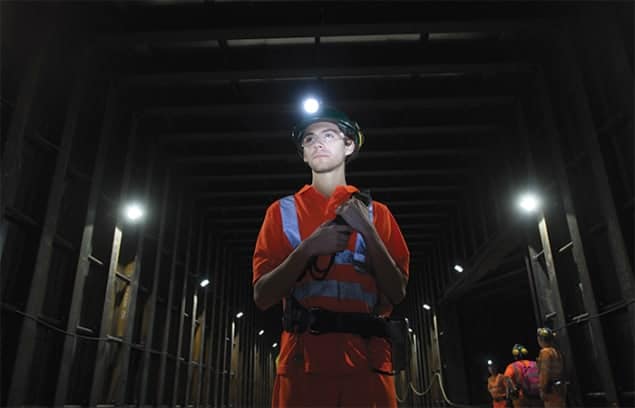
Walkers on the Cleveland Way footpath in the north-east of England get to enjoy not only the heather-covered North York Moors but also some stunning coastal scenery. Nowhere are the views more dramatic than at Boulby Cliff – the highest point on the east coast of England at a shade over 200 m above sea level. What most walkers won’t realize, however – as they wander the cliff-tops and breathe in the fresh North Sea air – is that more than a kilometre beneath their feet exists a hive of human activity. In the cavernous excavated tunnels far below, by the light of their headlamps, hundreds of people go about their day-to-day business.
Boulby Mine was established in the late 1960s to take advantage of rich seams of rock salt and potash – a soluble fertilizer containing potassium. The mine has been productive ever since, and now consists of a network of roadways and caverns extending out under the sea. More than 1000 km of tunnels have been excavated since operations began.
But since the early 1990s, miners have shared their workplace, as well as their commute – a 1.1 km vertical journey in a rattling lift cage – with physicists. That’s because, as Israel Chemicals Ltd UK (ICL-UK), the company operating the mine, proudly states on a sign up at ground level, the site is home to the “Boulby Underground Laboratory for Dark Matter Research – searching for the missing mass of the universe”. This facility is funded by the UK’s Science and Technology Facilities Council (STFC) and operated by a small onsite STFC team. The underground lab infrastructure has evolved over the years. A series of buildings has been constructed in specially excavated rock-salt caverns in the mine, culminating in the most recent building, the Palmer Laboratory – a 750 m2 fully outfitted cleanroom underground science facility.
Astroparticle physics research at the Boulby lab is thriving, and has focused since the turn of the millennium on searches for dark-matter particles. Boulby, like other underground labs in the world, is an ideal venue for looking for these elusive dark-matter particles as experiments can be operated almost entirely free from cosmic-ray-particle interference – a perpetual source of unwanted particle noise on the Earth’s surface. Early studies at Boulby included the ZEPLIN dark-matter detector, which pioneered a detection system that uses liquid xenon as the dark-matter “target”. This technology is now one of the most important in the world for research into dark matter, one of the leading candidates for which is weakly interacting massive particles (WIMPs). The most recent dark-matter experiments under way at Boulby include DRIFT-II, which aims to detect not only the energy of dark-matter particles but also their direction – the so-called “WIMP wind”. Another is DM-Ice, a dark-matter detector due to be installed at the South Pole, which aims to detect annual variation in WIMP signals caused by the motion of the Earth around the Sun, confirming (or refuting) an earlier positive result from a detector operated in the deep-underground Gran Sasso National Laboratory in Italy. (For more on direct dark-matter searches, see “Deep down for dark matter” below.)
Recently though, the range of studies under way at Boulby – and in other deep labs around the world – has been evolving and expanding. Many groups beyond particle physics have realized that these environments would benefit their research too, which has led to an explosion of funding proposals, followed by the diversification of these labs. Projects currently under way at Boulby include astrobiology, testing instrumentation for a new generation of robotic rovers and developing techniques to monitor buried carbon-dioxide (CO2) gas in future carbon capture and storage (CCS) schemes.
Each deep-underground lab has a unique offering depending on its location and geology, and laboratories are seeing a growth in the science they host beyond the usual astroparticle physics. At the Canfranc Underground Laboratory in Spain, for example, scientists are exploring the link between seismic activity and river discharge, and recently found that a certain portion of seismic noise measured there is indeed linked to the discharge of a local alpine stream, the River Aragon. At Gran Sasso, meanwhile, physicists are dating ice cores to high precision using low-background germanium detectors, which can detect faint gamma-radiation signatures corresponding to atmospheric nuclear tests and nuclear-reactor accidents.
Extraterrestrial aims
Boulby is at the forefront of this relatively new interest in diversifying the science undertaken by underground labs, with a host of exciting projects already under way or planned. The similarity between the underground environment at Boulby and the extraterrestrial subsurface environment of, for example, Mars, makes Boulby an ideal location for testing a new generation of troglodytic rovers. Such rovers, which are designed to navigate and explore remote and alien environments, could one day beam back science data from deep below the Martian surface.
A new European space-exploration programme called MASE (Mars Analogues for Space Exploration) is associated with this research. Scientists from MASE as well as NASA are studying life deep underground and are testing a range of technologies to look for it. This work is carried out in rock-salt caverns at Boulby, some of which are located many kilometres away from the Boulby mine shafts, remote and deep under the North Sea. “If we want to successfully explore Mars,” says Charles Cockell, director of the UK Centre for Astrobiology, “we need to go to Mars-like places on Earth. The deep, dark environment of Boulby Mine is the ideal place to understand underground life and test space technologies for the exploration of Mars.”
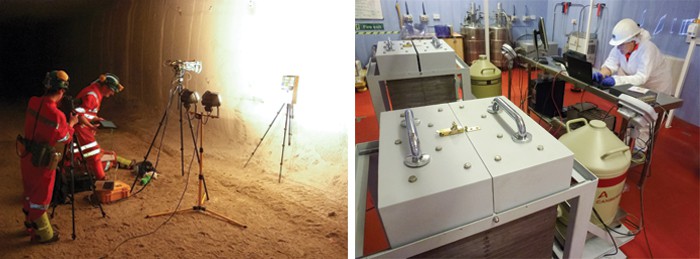
New instruments being developed for these troglodytic rovers include rock-breaking tools for cracking open the secrets of Martian geology, and miniaturized gas-analysis instruments designed to sniff out gases such as methane, which are the chemical signatures of life. This research could also be applied closer to home, in working mines, for example by revealing the presence of dangerous gases, or in the robotic exploration of collapsed mine tunnels deemed too dangerous for humans to enter. Indeed, one of the key goals of the Boulby International Subsurface Astrobiology Laboratory (BISAL) is to provide a platform for knowledge transfer between the space exploration and mining communities.
A related arm of research at Boulby is the rapidly expanding field of astrobiology, which has been motivated for the past two decades by the study of exoplanets as well as planetary bodies in our own solar system. We currently have a catalogue of around 1900 known planets, a handful of which appear to be within the so-called “habitable zone”, where the temperature and pressure allow liquid water to exist on the planet’s surface, including (obviously) Earth, and (perhaps less obviously) Mars. Exoplanets in the habitable zone may be habitable, but that’s not to say they are hospitable, and there is growing interest in studying terrestrial life here on Earth that has eked out an existence in extreme environments that may mirror those found on other planets.
Extreme environments include those at the edge of the habitable zone’s temperature–pressure envelope, as well as low-background-radiation environments and very salty environments. An example of the latter is found at Boulby, where the mine tunnels are carved into a layer of 250-million-year-old evaporite rock known as the Zechstein Supergroup. This unit of sedimentary rock, which includes minerals formed by the evaporation of a saline solution, contains similar minerals to those recently detected on Mars.
This is where the extremophiles being studied can be found – hardy microscopic biota, with a slow metabolism, living on the salty rock surfaces. Astrobiologists take samples from the rock faces and study them in situ in the BISAL clean room, making Boulby perhaps the only place in the world where such extremophiles can be studied with such minimal risk of contamination.
Monitoring carbon capture
Understanding our own planet is also high on the research agenda at Boulby. One process we are increasingly using here on Earth, but do not yet fully understand, is CCS. This is the practice of capturing CO2 produced by burning fossil fuels and then injecting it underground so that it doesn’t add to greenhouse-gas levels. CCS has huge potential to ameliorate anthropogenic climate change, provided that the injected CO2 remains locked away rather than leaking back into the atmosphere.
Project Deep Carbon at Boulby is developing muon detectors to monitor CO2 stored in deep saline aquifers – one of several types of storage sites being used for CCS, in which the gas displaces salt water in a layer of permeable rock. The muon-monitoring technique being used is analogous to medical CT scans: just as X-rays are used in CT scans to make non-invasive 3D images of a patient’s insides, cosmic-ray muons can be used to non-invasively image anything between their point of origin in the upper atmosphere and a detector on or under the ground. The ultimate goal is a compact, rugged muon detector that can be inserted into a borehole beneath an aquifer, where it would then monitor the muon flux it receives. Such measurements could then provide a much-needed means of tracing the movement of CO2 in the CCS process since, for instance, when CO2 is injected into the rock pore space it will displace brine which has a higher density than CO2 and is better at blocking muons. At the moment such data can only be acquired at high cost and episodically through techniques such as seismic surveys. Jon Gluyas, project leader and professor of geoenergy carbon capture and storage at the University of Durham, UK, says “Muon tomography offers an opportunity for an important additional passive 24/7 monitoring system that could also significantly cut costs.”
The location of Boulby Mine provides a very good facsimile for where a muon detector will be placed in practice – in a deep borehole below lots of rock, liquid and gas. Indeed, in the tunnels in Boulby Mine that extend beneath the sea, a detector would have above it plenty of rock, as well as water.
Project Deep Carbon is currently in “proof of principle” phase, with two studies under way: a borehole-positioned detector being in situ performance-tested in a rock wall near the underground laboratory; and the Muon Tides detector, soon to be installed in a remote cavern 764 m below sea level, where it will demonstrate the sensitivity of the technique by measuring the tiny change in muon flux caused by the ebb and flow of the tide. There the instrument will monitor the 50 m deep water above and, by integrating data over time, researchers hope to be able to detect the twice-daily 3 m change in tide.
Materials dating and screening
Another unique opportunity created by the tiny cosmic background levels in underground labs is the ability to measure, using gamma-ray spectroscopy and other techniques, ultralow levels of radioactivity emitted by test materials or samples, with greater sensitivity and precision than would be possible on the surface.
One use of gamma spectroscopy in which a low gamma-ray background is needed is dating environmental samples. Many readers will be familiar with the technique of radio carbon dating, in which the ratio of unstable 14C atoms to those of stable 12C is used to date samples up to 50,000 years old. Perhaps less well known is the fact that similar techniques applied to the radioisotopes 210Pb and 32Si provide a means for more precise short- and mid-range radiometric chronometry. Using gamma-ray spectroscopy and other techniques to measure the decay of these isotopes, researchers can apply radio-dating techniques over different time periods. Applications include health – linking risk factors with certain diseases in epidemiology studies – sediment dating and the dynamics of various environmental processes.

Another use of ultralow-background gamma spectroscopy is to screen materials to be used in “rare-event physics” experiments. Many of the rare-event searches that have traditionally dominated the science programmes of underground labs are still under way, and many of the questions they set out to answer (Does neutrinoless double-beta decay occur in nature? Does the proton decay?) remain open and important to this day. The latest incarnations of these experiments are collecting data as you read this, and are continuing to push down the limits on the probabilities – known as cross-sections – of the rare particle-interaction processes that researchers hope to observe.
These cross-sections are now incredibly tiny, and this means that even a very low rate of background events from, for example, radiological impurities in the detector materials, could severely hamper experimental sensitivity. A rigorous materials-screening programme is therefore implemented by all such experiments. The lab at Boulby, with its 1.1 km of muon shielding, low-activity halite cavern, and extremely low levels of the radioactive gas radon, is an ideal place to do this.
Scientists at Boulby are currently checking materials for several underground-lab experiments, including the LUX–ZEPLIN (LZ) dark-matter search experiment: the seven-tonne successor to the LUX experiment, due to enter its three-year construction period at the Sanford Underground Research Facility in the US this year. “The core of LZ will be the most radiologically quiet place on Earth at these energies,” says Chamkaur Ghag from the LZ group at University College London in the UK.
Other experiments for which Boulby is screening materials include the SuperNEMO neutrinoless-double-beta-decay project, which is to be constructed at the Modane laboratory on the Italian–French border. The facilities are being used by firms as well, to screen materials or devices – such as low-activity metals and photomultipliers – that they intend to supply to current and future rare-event projects.
Time to expand
The future looks bright for the world’s underground labs, with already diverse science programmes set to expand in the coming years as more research groups realize the possibilities offered by these uniquely quiet corners of the universe.
At Boulby, the science programme is expanding and so are the facilities. The STFC has recently granted £1.8m to build a brand new underground lab adjacent to the existing one, to host science at Boulby for the next decade. As well as providing a site for multidisciplinary studies like those described in this article, the new lab will also host and support the UK’s efforts in the world’s next-phase dark-matter-search experiments.
The Palmer Laboratory at Boulby was built to fit into an existing tunnel. It is now nearly 15 years old and shows wear and tear from gradual rock movement caused by its proximity to a nearby geological fault. The cavern in which the new lab will be located is distant from this fault – and the lab is being custom built to be significantly taller and wider than the Palmer Laboratory. ICL-UK has already completed excavation of the more than 4000 m3 cavern for the new lab and assisted in the initial outfitting, set to be complete by the end of this year. The fact that the firm is applying its own effort to the project is testament to the close relationship enjoyed by the science and mining operations at Boulby, a rare but positive example of a symbiotic marriage of pure (and now applied) science and industry.
The deep labs of today are a far cry from the dusty caverns of the first underground rare-event experiments of the 1970s. The science portfolio of these laboratories is evolving too, and Boulby, along with its international counterparts, is undertaking a growing range of multidisciplinary underground science studies – ushering in a new era of discovery deep beneath our feet.
Deep down for dark matter
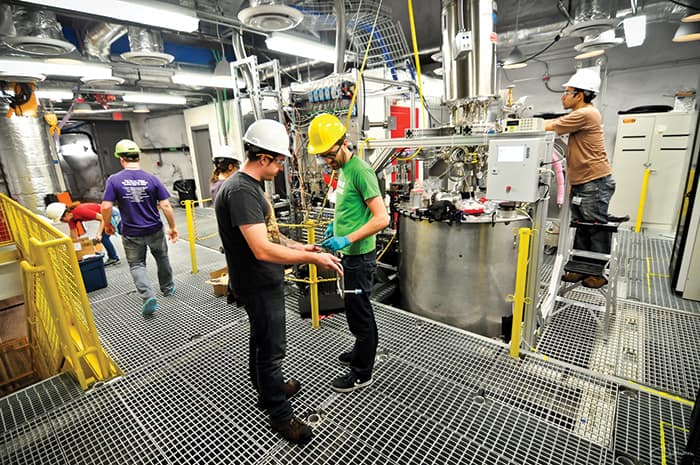
In the early days of deep underground labs, researchers typically used sensitive detectors to search for rare astroparticle-physics events such as neutrino scattering, neutrinoless double-beta decay and the decay of the proton. However, at around the turn of the millennium, a new programme of rare-event searches took off in the form of direct searches for dark matter. In a direct search, an experiment looks for direct interactions of the particles themselves, whereas in an indirect search, one looks for the gravitational effects these particles have on other, visible objects, or for what the particles produce when they interact in distant regions of the galaxy.
Thought to make up 85% of the universe’s mass, the particle nature of dark matter still eludes us. Most scientists are pinning their hopes on a class of particles called WIMPs (weakly interacting massive particles), which are expected to leave behind a feeble energy signature on the rare occasions that they interact in whatever sensitive target medium is used in the detectors designed and built to observe them. For this reason, all of the world’s direct dark-matter search experiments are sited in underground labs, where a thick layer of bedrock shields them from unwanted particle interference from cosmic rays, which are ever-present at the Earth’s surface.
The Boulby Underground Laboratory in the UK currently hosts DRIFT-II, which is a 1 m3 chamber filled with low-pressure gas, designed to detect not only the energy but also the direction of dark-matter particles: the so-called “WIMP wind”. Boulby also hosts the emerging DM-Ice experiment – a sodium-iodide scintillator array designed to detect the annual change in WIMP signal rate caused by the motion of the Earth around the Sun and its subsequent change in speed relative to the Milky Way’s dark-matter halo.
In other deep labs, some notable experiments use a technique pioneered by the ZEPLIN collaboration, in which a detector is filled with a noble element such as xenon, which exists both in liquid form at the bottom of the chamber and as gas at the top. The idea behind such two-phase noble-liquid detectors is that dark-matter particles interact in the liquid, releasing scintillation light, and charge, which drifts to the gas phase, causing another scintillation flash. Recording these flashes with high-sensitivity, low-background photomultiplier tubes allows the location of the interaction in the detector to be determined. Comparing the size of the two light pulses also gives a means of identifying which type of particle has been detected – a WIMP, or an earthly background-radiation particle.
Such detectors are currently being used in the XENON experiment at Gran Sasso National Laboratory in Italy and the LUX experiment at the newly renovated Sanford Underground Research Facility in the US, which occupies the very same experimental hall in which the future Nobel-prize-winning physicist Ray Davis Jr first discovered solar neutrinos. At the time of writing, LUX is the most sensitive dark-matter detector in the world.

